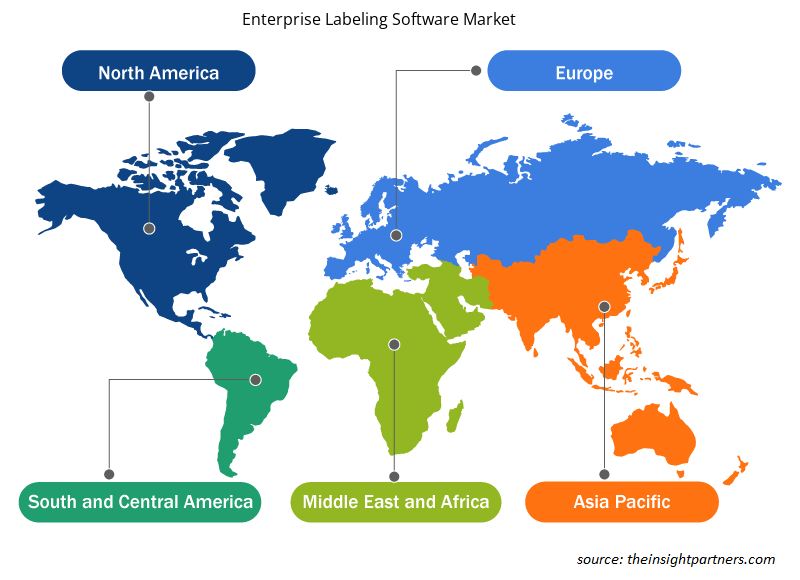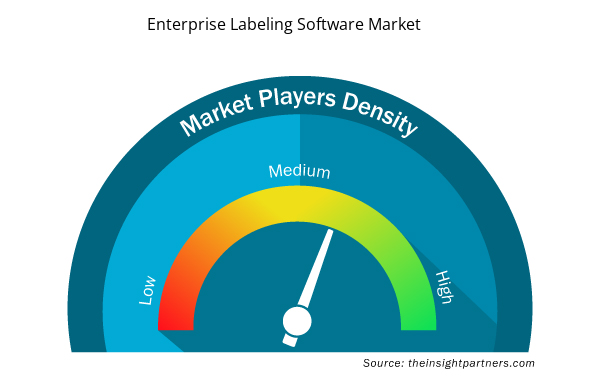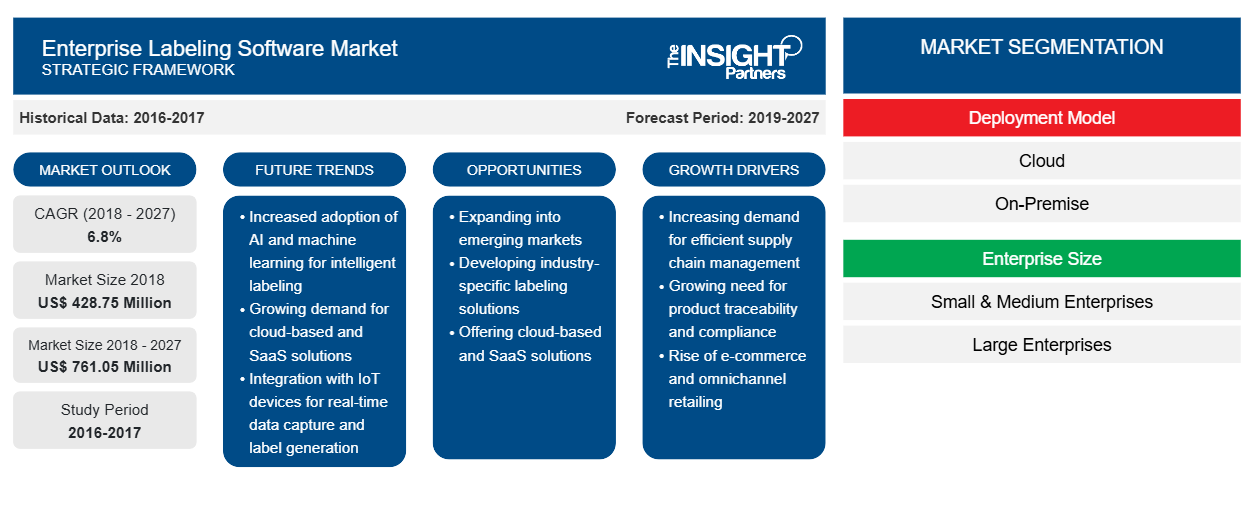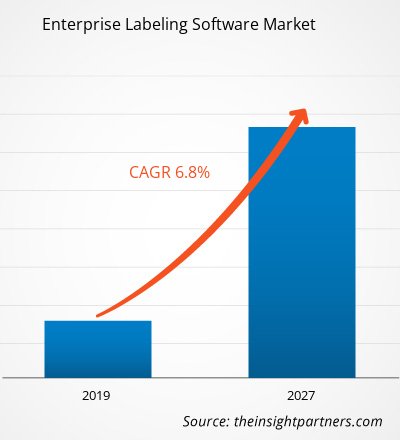El mercado de software de etiquetado empresarial se valoró en US$ 428,75 millones en 2018 y se espera que alcance los US$ 761,05 millones para 2027 con una tasa de crecimiento CAGR del 6,8% durante el período de pronóstico.
La expansión de diversas industrias de uso final en todo el mundo, especialmente en APAC y MEA, junto con la evolución de la gestión y planificación de datos en los últimos años, ha introducido el etiquetado como una operación crítica para el negocio de muchas pequeñas y medianas empresas. Existe una creciente necesidad de etiquetado empresarial en diversas industrias de uso final para agilizar múltiples operaciones comerciales. El software de etiquetado empresarial ayuda a mantener la precisión durante el proceso de impresión y garantiza el cumplimiento de las empresas con las regulaciones de divulgación de información del producto. Además, la integración de este software ofrece varios beneficios, incluida la colaboración de datos a nivel empresarial, la eficiencia de la cadena de suministro y la flexibilidad y consistencia de la impresión de etiquetas. Por lo tanto, se espera que la mayor adopción del etiquetado empresarial impulse el crecimiento del mercado de software de etiquetado empresarial.
El software de etiquetado empresarial mejora la velocidad, la precisión, la eficiencia, el ahorro de costes y el tiempo de entrega, al tiempo que permite a las empresas abordar desafíos complejos de etiquetado. La calidad mejorada del etiquetado ayuda a mejorar la ventaja competitiva de la empresa en el mercado global.
Personalice este informe según sus necesidades
Obtendrá personalización en cualquier informe, sin cargo, incluidas partes de este informe o análisis a nivel de país, paquete de datos de Excel, así como también grandes ofertas y descuentos para empresas emergentes y universidades.
- Obtenga las principales tendencias clave del mercado de este informe.Esta muestra GRATUITA incluirá análisis de datos, desde tendencias del mercado hasta estimaciones y pronósticos.
Perspectivas regionales del mercado de software de etiquetado empresarial
Los analistas de Insight Partners explicaron en detalle las tendencias y los factores regionales que influyen en el mercado de software de etiquetado empresarial durante el período de pronóstico. Esta sección también analiza los segmentos y la geografía del mercado de software de etiquetado empresarial en América del Norte, Europa, Asia Pacífico, Oriente Medio y África, y América del Sur y Central.

- Obtenga datos regionales específicos para el mercado de software de etiquetado empresarial
Alcance del informe de mercado de software de etiquetado empresarial
| Atributo del informe | Detalles |
|---|---|
| Tamaño del mercado en 2018 | US$ 428,75 millones |
| Tamaño del mercado en 2027 | US$ 761,05 millones |
| Tasa de crecimiento anual compuesta (CAGR) global (2018-2027) | 6,8% |
| Datos históricos | 2016-2017 |
| Período de pronóstico | 2019-2027 |
| Segmentos cubiertos | Por modelo de implementación
|
| Regiones y países cubiertos | América del norte
|
| Líderes del mercado y perfiles de empresas clave |
|
Densidad de actores del mercado de software de etiquetado empresarial: comprensión de su impacto en la dinámica empresarial
El mercado de software de etiquetado empresarial está creciendo rápidamente, impulsado por la creciente demanda de los usuarios finales debido a factores como la evolución de las preferencias de los consumidores, los avances tecnológicos y una mayor conciencia de los beneficios del producto. A medida que aumenta la demanda, las empresas amplían sus ofertas, innovan para satisfacer las necesidades de los consumidores y aprovechan las tendencias emergentes, lo que impulsa aún más el crecimiento del mercado.
La densidad de actores del mercado se refiere a la distribución de las empresas o firmas que operan dentro de un mercado o industria en particular. Indica cuántos competidores (actores del mercado) están presentes en un espacio de mercado determinado en relación con su tamaño o valor total de mercado.
Las principales empresas que operan en el mercado de software de etiquetado empresarial son:
- Software BLUE, LLC
- Corporación CYBRA
- Sistemas de datos internacionales, Inc. (DSI)
- Endecha,
- Euro Plus Ltd.
Descargo de responsabilidad : Las empresas enumeradas anteriormente no están clasificadas en ningún orden particular.

- Obtenga una descripción general de los principales actores clave del mercado de software de etiquetado empresarial
Los actores que operan en el mercado de gestión de contenido empresarial se centran en estrategias como fusiones, adquisiciones e iniciativas de mercado para mantener sus posiciones en el mercado. A continuación, se enumeran algunos de los desarrollos de los actores clave:
- En noviembre de 2019, NiceLabel lanzó la versión 2 de su paquete ABAP, compatible con SAP ECC y SAP S/4HANA. Esto permite a las organizaciones digitalizar por completo el proceso de control de calidad del etiquetado y reducir tanto los errores de etiquetado como los retrasos en los envíos.
- En abril de 2018, Innovatum, Inc. anunció la certificación ISO 9001:2015 para su sistema de gestión de calidad para el desarrollo, entrega y soporte de software como proveedor de software de ciencias biológicas, por parte de un organismo acreditado por ANAB.
Segmentos del mercado global de software de etiquetado empresarial:
Mercado de software de etiquetado empresarial: por modelo de implementación
- En las instalaciones
- Nube
Mercado de software de etiquetado empresarial: por tamaño de empresa
- Pequeña y mediana empresa
- Gran empresa
Mercado de software de etiquetado empresarial: por usuario final
- Bienes de consumo masivo
- Minorista
- Cuidado de la salud
- Almacenamiento y Logística
- Otros
Mercado de software de etiquetado empresarial: por geografía
América del norte
- A NOSOTROS
- Canadá
- México
Europa
- Francia
- Alemania
- Italia
- España
- Reino Unido
- Resto de Europa
Asia Pacífico (APAC)
- Australia
- Porcelana
- India
- Japón
- Resto de APAC
Oriente Medio y África (MEA)
- Arabia Saudita
- Emiratos Árabes Unidos
- Sudáfrica
- Resto de MEA
América del Sur (SAM)
- Brasil
- Resto de SAM
Empresas
- Software BLUE, LLC (Esko)
- Corporación CYBRA
- Sistemas de datos internacionales, Inc. (DSI)
- Endecha
- Euro Plus Ltd
- Innovatum, Inc.
- Productos de Loftware, Inc.
- PRISYM ID Ltda.
- Gaviota Científica, Inc.
- Teklynx Newco SAS
- Análisis histórico (2 años), año base, pronóstico (7 años) con CAGR
- Análisis PEST y FODA
- Tamaño del mercado Valor/volumen: global, regional, nacional
- Industria y panorama competitivo
- Conjunto de datos de Excel



Report Coverage
Revenue forecast, Company Analysis, Industry landscape, Growth factors, and Trends

Segment Covered
This text is related
to segments covered.

Regional Scope
North America, Europe, Asia Pacific, Middle East & Africa, South & Central America

Country Scope
This text is related
to country scope.
Preguntas frecuentes
Various end-use industries have used reporting solutions and business intelligence (BI) with many of their enterprise applications to improve business operations. Companies are looking forward to using BI to monitor labels printed across facilities to ensure that the quality of labels printed is in line with the expected output of a facility. Moreover, they are looking forward to using this insight for better maintenance schedules for printers and analyzing trends in the label production to fine-tune labeling environments. Therefore, the use of analytics with enterprise labeling is a major emerging trend for enterprise labeling software market.
The growth of the enterprise labeling software market in Europe is primarily attributed to the strong retail industry in countries such as India, China, and Japan, owing to the strong customer base. Also, the FMCG industry in countries such as India and China plays a vital role in supporting any country’s economy. Since the demand for enterprise labeling software is high across the FMCG sector; therefore, a strong FMCG sector supports the increasing demand for enterprise labeling software in the region.
The growing demand for enterprise labeling software in end-use industries in emerging economies such as MEA and APAC is driving the growth of enterprise labeling software market. Also, the surging demand for flexible enterprise labeling solutions to reduce the inconsistency, and improve efficiency is also a major driving factor for the enterprise labeling software market.
Trends and growth analysis reports related to Technology, Media and Telecommunications : READ MORE..
The List of Companies
- BLUE Software, LLC
- CYBRA Corporation
- Data Systems International, Inc. (DSI)
- Endicia,
- Euro Plus Ltd.
- Innovatum, Inc.
- Loftware, Inc.
- PRISYM ID Ltd.
- Seagull Scientific, Inc.
- Teklynx Newco SAS.
The Insight Partners performs research in 4 major stages: Data Collection & Secondary Research, Primary Research, Data Analysis and Data Triangulation & Final Review.
- Data Collection and Secondary Research:
As a market research and consulting firm operating from a decade, we have published and advised several client across the globe. First step for any study will start with an assessment of currently available data and insights from existing reports. Further, historical and current market information is collected from Investor Presentations, Annual Reports, SEC Filings, etc., and other information related to company’s performance and market positioning are gathered from Paid Databases (Factiva, Hoovers, and Reuters) and various other publications available in public domain.
Several associations trade associates, technical forums, institutes, societies and organization are accessed to gain technical as well as market related insights through their publications such as research papers, blogs and press releases related to the studies are referred to get cues about the market. Further, white papers, journals, magazines, and other news articles published in last 3 years are scrutinized and analyzed to understand the current market trends.
- Primary Research:
The primarily interview analysis comprise of data obtained from industry participants interview and answers to survey questions gathered by in-house primary team.
For primary research, interviews are conducted with industry experts/CEOs/Marketing Managers/VPs/Subject Matter Experts from both demand and supply side to get a 360-degree view of the market. The primary team conducts several interviews based on the complexity of the markets to understand the various market trends and dynamics which makes research more credible and precise.
A typical research interview fulfils the following functions:
- Provides first-hand information on the market size, market trends, growth trends, competitive landscape, and outlook
- Validates and strengthens in-house secondary research findings
- Develops the analysis team’s expertise and market understanding
Primary research involves email interactions and telephone interviews for each market, category, segment, and sub-segment across geographies. The participants who typically take part in such a process include, but are not limited to:
- Industry participants: VPs, business development managers, market intelligence managers and national sales managers
- Outside experts: Valuation experts, research analysts and key opinion leaders specializing in the electronics and semiconductor industry.
Below is the breakup of our primary respondents by company, designation, and region:

Once we receive the confirmation from primary research sources or primary respondents, we finalize the base year market estimation and forecast the data as per the macroeconomic and microeconomic factors assessed during data collection.
- Data Analysis:
Once data is validated through both secondary as well as primary respondents, we finalize the market estimations by hypothesis formulation and factor analysis at regional and country level.
- Macro-Economic Factor Analysis:
We analyse macroeconomic indicators such the gross domestic product (GDP), increase in the demand for goods and services across industries, technological advancement, regional economic growth, governmental policies, the influence of COVID-19, PEST analysis, and other aspects. This analysis aids in setting benchmarks for various nations/regions and approximating market splits. Additionally, the general trend of the aforementioned components aid in determining the market's development possibilities.
- Country Level Data:
Various factors that are especially aligned to the country are taken into account to determine the market size for a certain area and country, including the presence of vendors, such as headquarters and offices, the country's GDP, demand patterns, and industry growth. To comprehend the market dynamics for the nation, a number of growth variables, inhibitors, application areas, and current market trends are researched. The aforementioned elements aid in determining the country's overall market's growth potential.
- Company Profile:
The “Table of Contents” is formulated by listing and analyzing more than 25 - 30 companies operating in the market ecosystem across geographies. However, we profile only 10 companies as a standard practice in our syndicate reports. These 10 companies comprise leading, emerging, and regional players. Nonetheless, our analysis is not restricted to the 10 listed companies, we also analyze other companies present in the market to develop a holistic view and understand the prevailing trends. The “Company Profiles” section in the report covers key facts, business description, products & services, financial information, SWOT analysis, and key developments. The financial information presented is extracted from the annual reports and official documents of the publicly listed companies. Upon collecting the information for the sections of respective companies, we verify them via various primary sources and then compile the data in respective company profiles. The company level information helps us in deriving the base number as well as in forecasting the market size.
- Developing Base Number:
Aggregation of sales statistics (2020-2022) and macro-economic factor, and other secondary and primary research insights are utilized to arrive at base number and related market shares for 2022. The data gaps are identified in this step and relevant market data is analyzed, collected from paid primary interviews or databases. On finalizing the base year market size, forecasts are developed on the basis of macro-economic, industry and market growth factors and company level analysis.
- Data Triangulation and Final Review:
The market findings and base year market size calculations are validated from supply as well as demand side. Demand side validations are based on macro-economic factor analysis and benchmarks for respective regions and countries. In case of supply side validations, revenues of major companies are estimated (in case not available) based on industry benchmark, approximate number of employees, product portfolio, and primary interviews revenues are gathered. Further revenue from target product/service segment is assessed to avoid overshooting of market statistics. In case of heavy deviations between supply and demand side values, all thes steps are repeated to achieve synchronization.
We follow an iterative model, wherein we share our research findings with Subject Matter Experts (SME’s) and Key Opinion Leaders (KOLs) until consensus view of the market is not formulated – this model negates any drastic deviation in the opinions of experts. Only validated and universally acceptable research findings are quoted in our reports.
We have important check points that we use to validate our research findings – which we call – data triangulation, where we validate the information, we generate from secondary sources with primary interviews and then we re-validate with our internal data bases and Subject matter experts. This comprehensive model enables us to deliver high quality, reliable data in shortest possible time.


 Obtenga una muestra gratuita de este informe
Obtenga una muestra gratuita de este informe